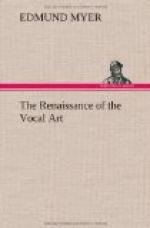Emotional or Self-Expression.
Theory.—Vitalized emotional energy, the “Singer’s Sensation,” is the true motor power of the voice.
Devices.—A study of tone-color and tone-character; the idealized tone, applied and developed by the use of words and sentiment.
The student of the voice who has studied, understood, and, to a certain extent, mastered the first three great principles of voice production—the removal of all restraint, automatic breathing, high placing, and low resonance—has certainly accomplished much. He has aroused and developed the physical and mental vitality of the singer, the vitality and energy of body and mind. This is the limit of progress or development with many, at least so far as actual tone study is concerned.
There comes a time, however, in the experience of every student of the voice, a stage of the study, when, if he expects to be an artist, he must take a step in advance, a step higher; he must place himself upon a higher plane or level; he must arouse his true inner nature, the singer’s sensation, that which we have called the third power. This is done by a study of emotional, or self-expression. It is done through arousing and vitalizing the emotional energy. Vitalized emotional energy, the singer’s sensation, is undoubtedly the true motor power of the artist.
At just what stage of development the consideration of this higher form of study or expression should be placed before the mind of the pupil, is a question. Singers are so different, physically, mentally, and emotionally. With some I have found it best not to consider this side of the question until they have developed a fair vocal technique. This should be the case with emotional, nervous, excitable temperaments. With hard, cold, stiff, mechanical pupils, this is often the only way in which it is possible to arouse them, in order to give them a start, without wasting weeks or months of precious time.
The development of this principle of vitalized, emotional energy, depends, as a rule, upon freedom of voice and the true conditions of tone as before described. Therefore, in order to study this great question, in order to fully develop this higher form of expression, the singer must have mastered the flexible, vitalized movements given in this work, must have acquired through these movements absolute freedom of tone. Experience teaches us, however, that there are those who, while they learn, in a certain way, to do the movements comparatively well, yet do not entirely let go,—they do not free the voice. With such the study of tone color, and especially the study of soft color, not soft tone necessarily, but soft, emotional tone color, is their only salvation. It releases and relaxes all the rigid local tendencies.




